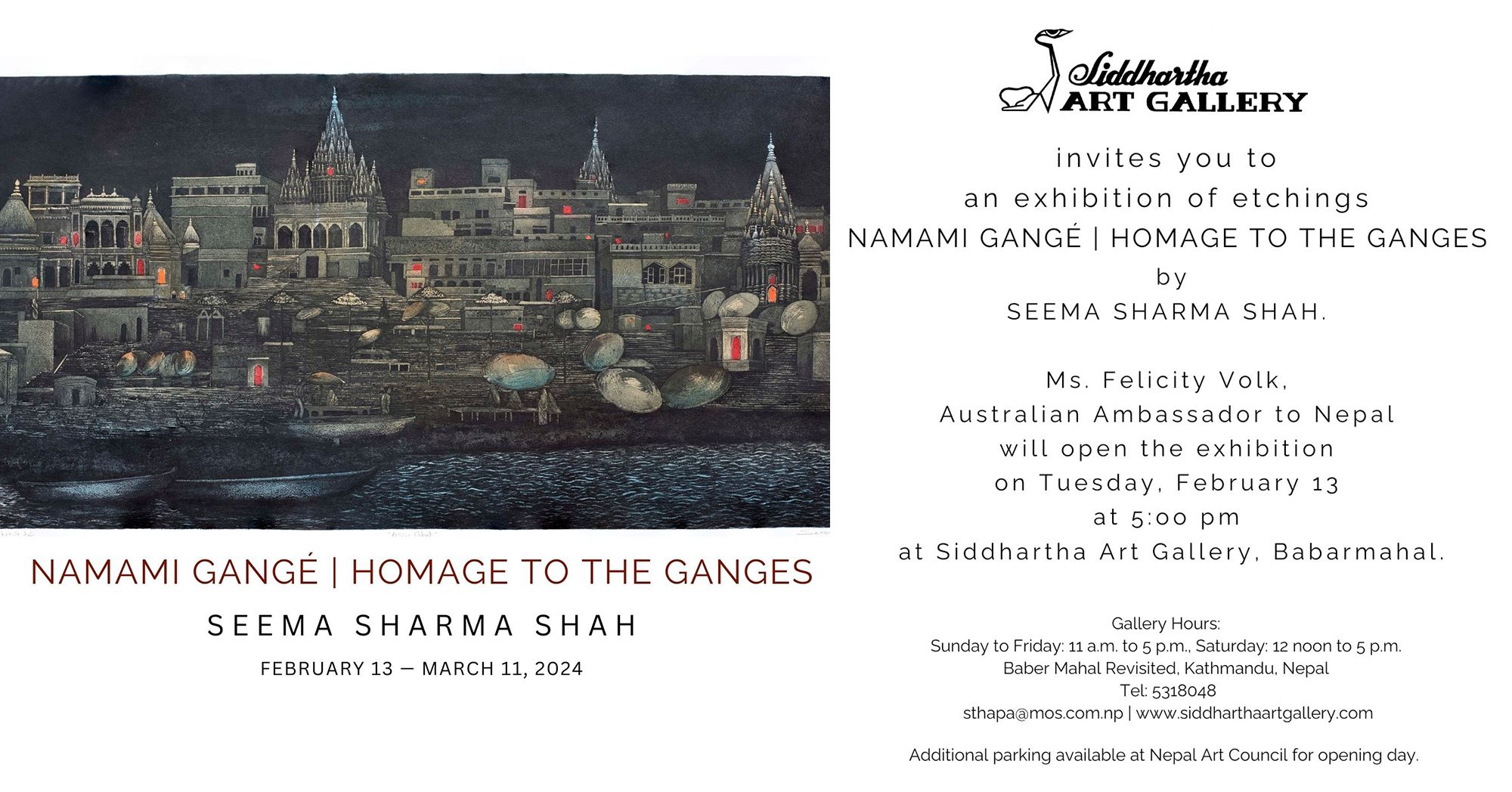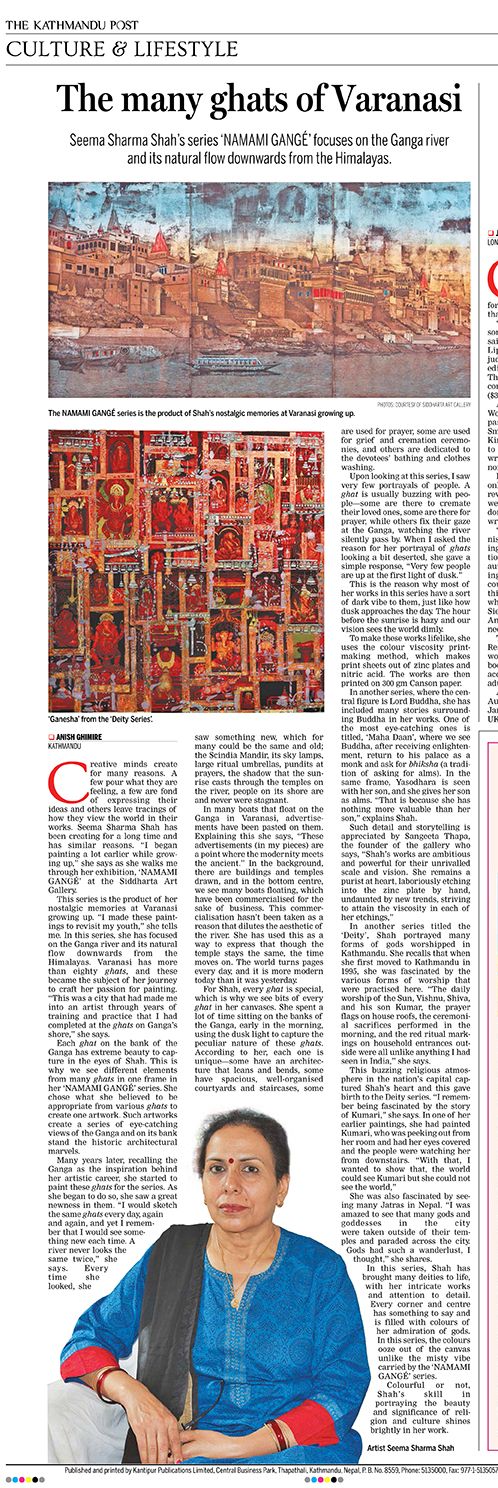WHEN: February 13 — March 11, 2024
WHERE: Siddhartha Art Gallery
Gallery Statement
The series Namame Gange by the printmaker Seema Sharma Shah marks her seventeenth solo exhibition and the seventh one at the Siddhartha Art Gallery. With this exhibition, Seema pays homage to Varanasi, the city where she was born, where she received formal academic training and where she met the love of her life—a fellow student—the Nepali artist Uma Shankar Shah, whom she married in April 1995. The marriage of these two artists is also a marriage of two cultures. No other city in India has closer spiritual ties to Nepal than this holy city on the banks of the Ganges. Varanasi and Kathmandu which are sister cities, celebrate the Shaivaite link or sacred geography between Kashi Vishwanath in India and Pashupatinath in Nepal. It is, therefore, not surprising that Seema’s work has always been imbued with the feeling of reverence and piety. In the process of creating her works, she becomes the ultimate pilgrim surreptitiously documenting the art and architecture of this magnificent city in chiaroscuro, the deities that are immortalized in stone and metal and the festivals that celebrate the faith of a pious populace.
This series, Namame Gange, was created during the pandemic when memories of home and all that was precious to the artist, seemed ephemeral. A dark palette reminiscent of her early works sets the mood and tone of these works in keeping with the times. The works are devoid of human activity save for the warm glow of the red lights that we see in the windows and the Deva Dipawali lanterns that are specially lit on the full moon of Kartik (November). Seema also documents the flags that have been installed as symbol of piety. So powerful are these memories of home, that the imagery presents itself almost like a surreal tableau frozen in time, devoid of the actors and players who could otherwise activate these city or temple-scapes. Even the Ganges is sans motion as the empty boats have no oarsmen. But this is precisely what Seema wants – her beloved city to herself – in one of her works of the ghats, she has included the bench she used to sit on as a student to draw the ghats.
Seema’s colourful etchings of various deities provide a powerful contrast to the more sombre Varanasi ghat series. These works are more consistent with her recent works, where she uses fragments of her early plates to create a unique collage or palimpsest of images that depict multiple deities, and particular festivals within the framework of a single work. Seema separates and unites these images by adorning these individual images with stenciled and embossed toranas and doorways so that the gods and goddesses are enshrined in their special niches. In some instances, the doorways and torans open up to the sky or an empty space to address the absence presence of a deity.
Seema’s works are ambitious and powerful for their unrivalled scale and vision. In a time where the digital and AI are coming to the forefront, she remains a purist at heart, laboriously etching into the zinc plate by hand, undaunted by new trends, striving to attain the viscosity in each of her etchings—a technique that both she and her husband Uma Shankar have mastered over the last 30 years and imparted to a new generation of printmakers in Nepal.
Sangeeta Thapa
Founder | Director
Namami Gangè Series
The Namami Gange Series focuses on the Ganga River and its natural flow downwards from the Himalayas. I thought of this idea in 2020 when we were locked inside our homes during the COVID-19 pandemic. During this time, I was reminded of my youth in Vanarasi. It was important for me to keep busy during the pandemic to cope with the abrupt changes due to COVID-19. I prayed that just like the river Ganga, the pandemic would flow away as well. This was a city that had made me into an artist through years of training and practice that I had completed at the ghats on Ganga’s shore. As a student, I would sketch the same ghats every day, again and again, and yet I remember that I would see something new each time. A river never looks the same twice. Years later, as I portray these ghats for the Namani Gange series, I see a great newness in them: the Scindia Mandir, its sky lamps, large ritual umbrellas, pundits at prayers, the shadow that the sunrise casts through the temples on the river, people on its shore are and never were stagnant.
Through these works, I have also tried to display a connection, how water from the Himalayan flows across the sub-continent and connects millions of people and places. The Ganga, which flows from the Varuna Ghat up to the Assi Ghat, gives name to the city of Varanasi, which has been a cultural and spiritual locus for people for thousands of years. Each ghat is special: some ghats allow the devotee to bathe and wash their clothes with the river’s water, some have bent and leaning architecture, others have large organised compounds and staircases, some conduct prayers and some are occupied by bereavement and rituals of cremation.
From the ghats of Varanasi, one can observe the pinnacles of the temples in the skyline and see their reflection in the water on the river’s shore. There is a place amongst these Ghats called Swargadwari, which is considered to be a gateway to heaven. At Manikarnika Ghat, the ritual burning of bodies has been going on for thousands of years... I feel that the city seems to possess the unique ability to transmit thousands of years of history through its architecture, traditions and culture.
My etchings have been created using the colour viscosity technique of printmaking, which uses nitric acid and zinc plates to create print sheets. The works are then printed on 300 gm Canson paper. My purpose for showing this work at this exhibition is to showcase Varanasi as it is today and its deep connections with the Himalayas. I want to showcase how the Ganga is worshipped, what rituals have formed around it and what the heritage around the river looks like today in relation to what it looked like in the past.
Dr Seema Sharma Shah
Artist | Printmaker
Deity Series
When I first moved to Nepal in 1995, I was fascinated by the various forms of worship that were practised here. The morning prayers, ritual sacrifices, prayer flags on roofs of houses, the daily worship of the Sun, Vishnu, Shiva and his son Kumar, and red ritual markings outside on the entrances of homes were all different from what I had experienced in India. From childhood, I had only seen people worshipping inside temples or in the puja rooms of their houses; it was astonishing to see an entire city in a state of constant worship and festival.
I was fascinated to see the worship of Kumari as a living goddess. What made me a little dejected was that I was unable to understand the history behind many of the rituals present here. The Living Goddess deeply influenced me through the way she was worshipped, how she lived her life, her hair, her dress and the third eye drawn on her forehead. It was during Indra Jatra that I felt most overwhelmed by the rituals and felt as if I had been in the presence of Gods. This experience inspired me to portray deities in my works, and I started sketching the Navadurgas as I used to in my childhood.
In Nepal, I witnessed many Jatras: Samyak Jatra, Sindur Jatra, Rato Machendranath Jatra, Bhoto Jatra, and Seto Machendranath Jatra and created a series of works on these jatras. I was amazed to see that many gods and goddesses in the city were taken outside of their temples and paraded across the city. Gods had such a wanderlust, I thought. When I saw the Samyak Jatra for the first time in Swayambhu, I again felt as if I had seen real gods themselves and as if statues of the Dipankar Buddhas had left their temples to congregate in a park. When I made these Buddhas a subject for my work, I was reminded of the various historical portrayals of Buddha from India, from the Ajanta murals of Padmapani Bodhisattva and the sites at Bodhgaya and Sarnath. This is why I created the series on the Buddha Circuit.
In my works, I have also created a series on the Ganesh, for which I derived inspiration from many temples across Kathmandu. I saw many different versions of the Ganesh, such as the Jor Ganesh, Jal Vinayak, and Surya Vinayak. Some Ganesh temples were full of bells, which was unique for me. I also saw many different forms of Hanuman, such as the Sankat Mochan, where Hanuman is portrayed as the one who defends against sankat or upheavals in life.
Some of my works are unique prints, which means that they were first created as zinc plate etching prints using the colour viscosity technique and then worked upon further with acrylic and metallic colours. I have also created a ‘soft’ effect with acid on the plate and incorporated stencil work, which took me over three months to complete. These works are printed on 300 gm Canson paper.
Dr Seema Sharma Shah
Artist | Printmaker


